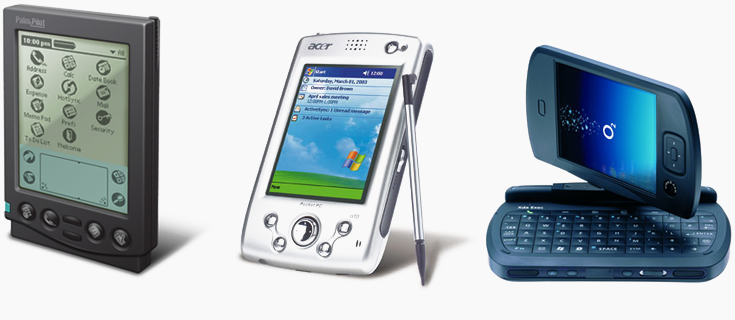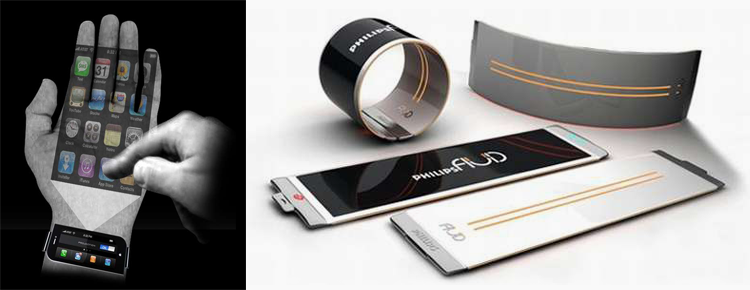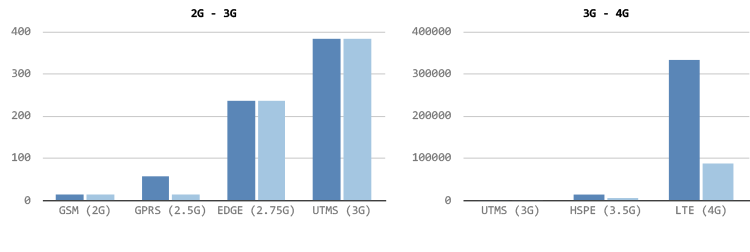We all have a smart phone. A tablet. A laptop. A plethora of different interconnected devices that allow us to share, create and consume things 24 hours a day. But what has the future to offer us?
Go back as little as 10 years and the outlook is quite bleak. There are devices capable of picking up your emails on the go, downloading and displaying webpages, albeit the now long forgotten WAP ones. The technology is there but the thing most lacking is access to affordable data plans to allow us to get at those things.

What mobile computing used to look like
With a premium on access, it is a very small subset of people who are at all concerned about providing you with access to their data via mobile platforms. Only the biggest players are interested in you being able to visit their websites on-the-go. Essentially only a small sub-set of the entire scope of the web is viewable on your device.
Fast forward to now. What do we have? Almost every device you purchase has some means of connecting you with the outside world; phones, tablets, watches, even glasses have the ability to reach out and pull down or share relevant data. Social services such as Facebook and Twitter are integrated left, right and centre; buy a new model camera and it's likely there's some sort of social media integration for sharing. We can automatically geo-tag photos, tweets and anything else we create on the move. The communications technology has finally become affordable enough to catch up with our devices.
So where to now? What's the next leap from the touch screen devices we have now? Will we see a continuation of form or will something else groundbreaking and seminal come to light that will change the future of handheld devices?

Credit to: Samuel Lee Kwon and Dinard da Mata
The disappointing truth for a lot of people is this: nothing truly groundbreaking has recently occurred, there was no eureka moment when someone discovered how to produce a capacitive touch screen device; they've been around for ages! Similarly, just as processor power becomes more abundant we are collectively building software that is fit for consumption on lower powered, more constrained devices — the shift is in consumer focus, not technological.
What we are seeing is an abundance of new incremental research into how these pieces of technology can be miniaturised, made more power friendly and improved upon so they can be embedded into our everyday devices. With that starts a snowball effect as a range of new companies join the market to research and develop improvements over what we're currently using.

Mobile network speeds. Dark blue shows the download capacity, light the upload. Values in Kbps, source
3G networks were a godsend when they first launched, the throughput you could get on your device rocketed overnight. The same is true of 4G networks which are still somewhat in their infancy. With each faster iteration, and plateauing pricing structure, the masses gain access to these faster speeds. This allow the consumption and creation of media at a much higher density. You can watch HD video on a bus on the way into work. You can stream live video feeds from your mobile phone to a cloud service as you see it happening. This is the next step in the evolution of handheld devices.
It's not about the form factor or the quirks of your device. It is about how unobstructed you are to access and create data in a distributed storage network. If you have access to a limitless sinkhole to store things, with a wide enough data channel to access and store data in real-time then your 8GB iPhone becomes a 2TB… a 10TB… an unlimited storage device. You don't have to worry about taking too many photos or if your camera has enough space for a video of the last dance at a wedding. We're moving, slowly but surely, back to the days where the device you're holding is nothing but a terminal, a veneer onto the underlying data that you're consuming and creating.

Cloud storage services
We're almost there. Network speeds are high, higher than they've ever been. Cloud storage is cheap, we have integrated solutions such as iCloud, Google Drive and Dropbox. But they're not ubiquitous, we're still grasping on to our old notions of what's 'on' a device, where things live and how we'll access them.
Of course there are still arguments for on-device storage for certain things — private data, caching for offline viewing and speed of access. These issues are diminished through a growing trust in these services and perhaps a change in how we use our devices to cache offline data.
The future is coming, but it's not in the form of a ubiquitous device that fits all your needs, what would be the benefit to you or the companies making them? Each of the devices we use fit specific niches, and they are built to be fit for purpose. You're not going to develop applications on an iPhone; you can edit video on a tablet but the best fit is a powerful desktop machine; my mobile phone isn't going to project a full OS onto a wall so I can use it wherever I am.
Skip forward another 10 years. Will your device be nothing more than a shell, a terminal to process graphics and display information held elsewhere? The beefy processing and storage needs taken care of by some cloud based entity that you subscribe to — all of your devices furnished with a purpose built veneer onto the collective data you've amassed that encompasses your entire digital life. Perhaps.